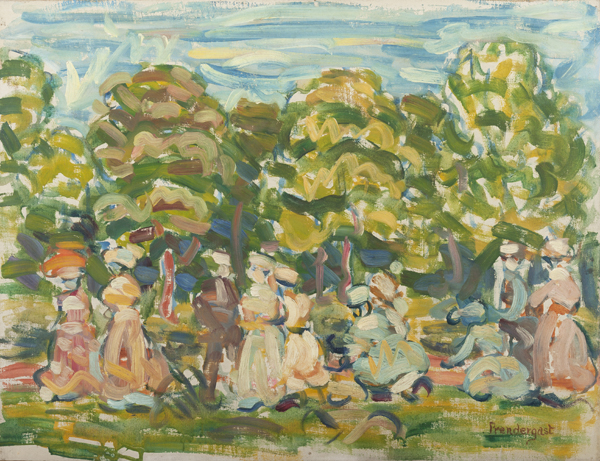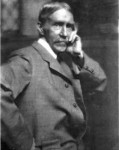
Maurice Prendergast
American, 1859-1924
Summer in the Park, 1905-1907 ca.
oil on canvas
15 ½ x 20 ¼ in.
SBMA, Gift of Mr. and Mrs. Sterling Morton
1959.52

Prendergast in 1913 - Photo by Gertrude Käsebier
“The love you liberate in your work is the only love you keep.” - Maurice Prendergast, 1905
RESEARCH PAPER
Maurice Prendergast was born in Newfoundland; the family moved to Boston when he was two. Upon graduating from eighth grade, he immediately went to work lettering show cards. He was handicapped by poverty, deafness, and uncertain health but he knew from the start he wanted to be a painter, and he let nothing stand in his way. His younger brother, Charles, an artist of gesso panel and decorative crafts, was determined to help.
Maurice did not get to Paris until he was nearly thirty years old, but stayed for three years. It was the time of the Symbolists, artists who turned away from the objective world toward an inward one of feelings derived from colors and forms. Several of the students at the Academie Julian, where Prendergast also studied, organized a group called the Nabis. They favored a flattened, artificial space of decorative patterns and disregarded conventional perspective. Prendergast, in uniting foreground and background in a single continuous plane, was painting in the style of the Nabi, as were Vuillard and Bonnard.
In 1895 the two brothers moved to Winchester, Massachusetts where Charles started a picture framing business, allowing Maurice to continue his painting and occasionally helping in the business. His first patron was Mrs. Montgomery Sears who, under the guidance of Mary Cassatt, was building a collection. With help from Sears, Maurice was able to go to Europe again in 1898, spending much of his time in Italy. He discovered the Venetian painter Carpaccio, an artist who shared his love of pageantry and processions.
Between 1900 and 1910 Prendergast visited New York frequently to paint. It was here he established his friendship with Glackens and other artists who eventually would make up “The Eight.” Our painting Summer in the Park was painted several years before his first exhibit with the group. In 1908 he exhibited in New York as one of “The Eight” and showed sixteen pieces. Reaction to them made it clear his original style had gone far beyond contemporary American taste: “Unadulterated slop”; Explosion in a paint factory”; Better it was seven rather than eight”. The wrath of the critics did not deter him. In 1913 his paintings in the Armory Show were among the most advanced by an American.
In his association with “The Eight,” Prendergast was the odd man out, described as an older independent painter from Boston who had traveled aboard more than the rest. He was never a realist, held no proletarian sympathies and was not a pupil of Henri’s. Prendergast belongs to a group of solitary, creative individuals who follow their own vision.
In the Museum’s painting, Summer in the Park, the conventional subject matter is in conflict with his radical style. There is little or no perspective, the shallow picture space made up of floating figures and trees makes little distinction between foreground and background. The objects in the picture are used as decorative motifs. Distinction between figure and ground is hazy, and contrasting hues are used for wavy, zigzag contour lines. He composed with an eye to the abstract design, not to recording a particular scene.
Prendergast’s general procedure was to sketch the composition in watercolor, developing the painting in oil later in his studio. He worked on a loosely stretched canvas, mixing little or no liquid medium with his paint. The canvas drew the heavy paint from the brush unevenly and irregularly, giving the painting a spongy softness. He stressed flatness and was preoccupied with the animation of the total painterly surface. Not until the Abstract Expressionists was the surface to assume such major importance to an artist.
After the Armory Show, renewed contact with French art stimulated a period of intense experimentation which lasted for five years. Prendergast tried new techniques and new subject matter—including portraits, nudes and imaginary landscapes—with mosaic-like application of paint similar to the technique of Paul Signac. His still life paintings showed the influence of Cezanne in their study of space and form.
By 1915 the Prendergast brothers were determined to move to New York. As always, Charles made it possible. He obtained a large order for frames from an insurance company in Philadelphia; on the strength of it the brothers left Boston and moved to a studio in the same building as their old friend, William Glackens. This decade that Maurice spent in New York was calm. Prendergast’s experiments were over. He returned to his former practice, in the summers visiting New England to do watercolors out-of-doors, in the winters, painting daily in his studio in oils. Acadia, done in 1922 and now in the Museum of Modern Art, is probably the last important oil he painted. His simple theme of people at leisure in out-of-doors settings fulfilled his own need for “making the world more beautiful than it is.”
BIBLIOGRAPHY
Maurice Prendergast-Art of the impulse and Color, Elenor Green
Maurice Prendergast 1859-1924 – Hedley Howell Rhys
“The Brothers Prendergast” – Art in America, March-April 1976
Quote
Ashton, Dore. Twentieth-Century Artist on Art. New York: Pantheon Books. 1985
Prepared for the Santa Barbara Docent Council by Katherine Griffin June 1980.
Typed and edited for the Docent Council website by Teda Pilcher by Lori Mohr, 2012.
SBMA CURATORIAL LABELS
The brilliant colors and expressive swipes of paint in this canvas capture the energy of figures in motion on a summer’s day. Prendergast was known for his lively scenes of crowds at the park or the beach, executed in watercolor, oil paint, or monotype prints. In this painting, the ground tone of the canvas is visible underneath his loosely brushed paint strokes, a method reminiscent of Prendergast’s watercolor technique, where he deliberately used the white of the page to create highlights. This technique contrasts with his later work, where he turned to a much thicker, impasto paint application, sometimes even painting on top of previous artworks to create mosaic-like textural surfaces.
- Highlights of American Art, 2020
